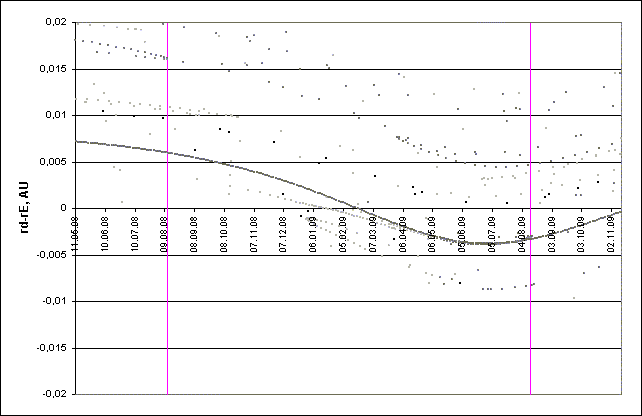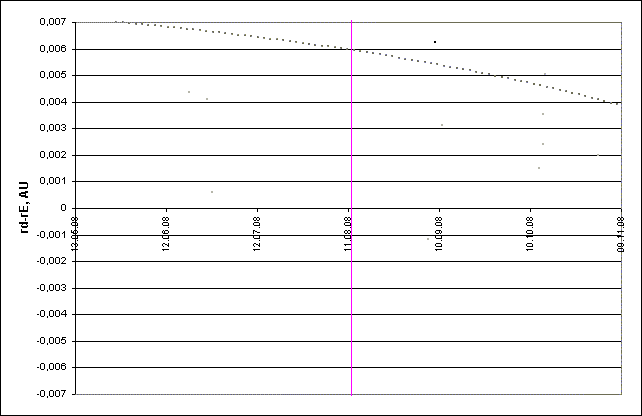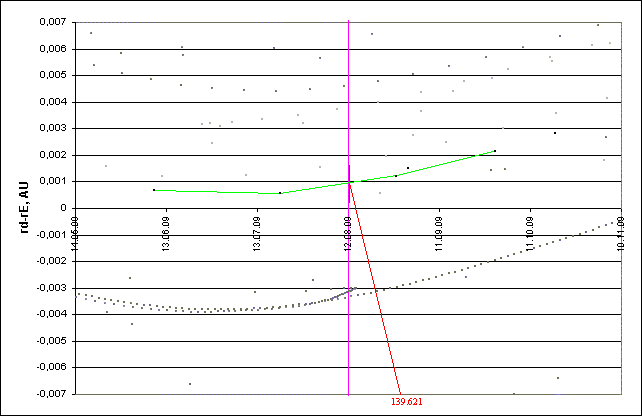Perseids 2008: prediction of activity
На страницу прогнозов
to the list of predictions
Introduction
Computation characteristics
We'd like to introduce the results of the Perseid meteor stream simulation aimed to the prediction of shower activity in 2008. The simulation was made for the trails of latest 7 revolutions, i.e, from the 1992 trail. The Author used the program by S. Shanov and S. Dubrovsky "Comet's Dust 2.0" to calculate orbital elements of ejected meteor particles. To estimate expected ZHRs for different encounters the model by E. Lyytinen and T. van Flandern given in their paper [4] was used with some Author's alterations made in order to adopt the model for ejection velocity (Vej) instead of da0 (difference in a-semimajor axis) and to convert the model from the Leonid stream (for which it was originally created) to the Perseids. The computation considered only gravitational forces, however, the results are on the whole in good accordance with these of other researchers. The prediction includes all encounters found within interval +/-0.007 a.u. The following parts of trails were computed: the first 5 rev. trails for ejection velocities [-50;100] m/s, 6-7 rev. trails - [-30;50] m/s.
Results
Introduction
Computation characteristics
We'd like to introduce the results of the Perseid meteor stream simulation aimed to the prediction of shower activity in 2008. The simulation was made for the trails of latest 7 revolutions, i.e, from the 1992 trail. The Author used the program by S. Shanov and S. Dubrovsky "Comet's Dust 2.0" to calculate orbital elements of ejected meteor particles. To estimate expected ZHRs for different encounters the model by E. Lyytinen and T. van Flandern given in their paper [4] was used with some Author's alterations made in order to adopt the model for ejection velocity (Vej) instead of da0 (difference in a-semimajor axis) and to convert the model from the Leonid stream (for which it was originally created) to the Perseids. The computation considered only gravitational forces, however, the results are on the whole in good accordance with these of other researchers. The prediction includes all encounters found within interval +/-0.007 a.u. The following parts of trails were computed: the first 5 rev. trails for ejection velocities [-50;100] m/s, 6-7 rev. trails - [-30;50] m/s.
Results

Fig. 1. Space-temporal projection of Perseids trails parts onto their minimal distance passages dirung the period 11.05.2008-12.11.2009 (correspondence between colours of the particles and their ejection velocities can be seen here).

Fig. 2. Detailed space-temporal projection of Perseids trails parts onto their minimal distance passages dirung the period 13.05.2008-09.11.2008 (correspondence between colours of the particles and their ejection velocities can be seen here).

Fig. 3. Detailed space-temporal projection of Perseids trails parts onto their minimal distance passages dirung the period 14.05.2009-10.11.2009 (correspondence between colours of the particles and their ejection velocities can be seen here).
As shown on the Fig. 1 and 2, in 2008 around the time of Perseid maximum the background part of the stream will be alsready slightly shifted towards the Earth's orbit (thanks to the Jupiter gravitation). So far we expect that traditional maximum of the shower will be a little more intense than usual, with ZHRmax up to 110-120 meteors. Also we faound two encounters with ery diffused 1479 and 1348 trails. Their parameters are given in the table below:
| trail | rD-rE | Vej | fM(fMD) | SL | MT |
| - | AU | m/s | - | ° | UT |
| 1479 | -0.00043 | 4.81 | 0.001 | 139.761 | 12.08.2008 5:29 |
| 1348 | 0.00011 | 2.13 | 0.000 | 139.835 | 12.08.2008 7:19 |
Computed ZHRmax from these encountes are around 1-2 meteors. Such activity is not detectable during the strong background activity. However, considering that computed ZHRmax values can be underestimations, observers are recommended to check these encounters. Meteor brightness from these trails is expected to be high.
In 2009 Perseid maximum will occur when the Earth's orbit will be intersected by particles, strongly perturbed by Jupiter. So far, the background part of the stream will be significantly closer to the Earth and we expect a strong increase of traditional Perseid maximum intensuty, appr. up to 200 meteors. Unfortunately, in 2009 Perseids will happen under moonlight, which severely decrease the impression from the activity. Also in 2009 will occur a number of encounters with 1872, 1737 and 1610 trails. The most interesting of them is the latter. The parameters of the enconters are given below:
| trail | rD-rE | Vej | fM(fMD) | SL | MT |
| - | AU | m/s | - | ° | UT |
| 1861 | -0.00335 | 31.32 | 0.079 | 139.478 | 12.08.2009 4:33 |
| 1737 | 0.00463 | 23.06 | 0.015 | 139.599 | 12.08.2009 7:35 |
| 1610 | 0.00094 | 11.82 | 0.005 | 139.621 | 12.08.2009 8:07 |
At given time 1610 trail can add 10-15 meteors on ZHR scale to the background activity. This should be detectable outburst. Also, average meteor brightness should increase around the peak. Observers are recommended to check this encounter.
References
1. "Comet's dust 2.0" program by S. Shanov and S. Dubrovsky. [Used for orbital computations.]
2. Information from Gary W. Kronk's page http://www.maa.agleia.de
3. IMO Meteor Shower Calendar 2006 http://www.imo.net/calendar/russian/2006/spring.
4. Lyytinen E, van Flandern T. "Predicting the strength of Leonid outbursts", 2000, Icarus, P. 158-160.